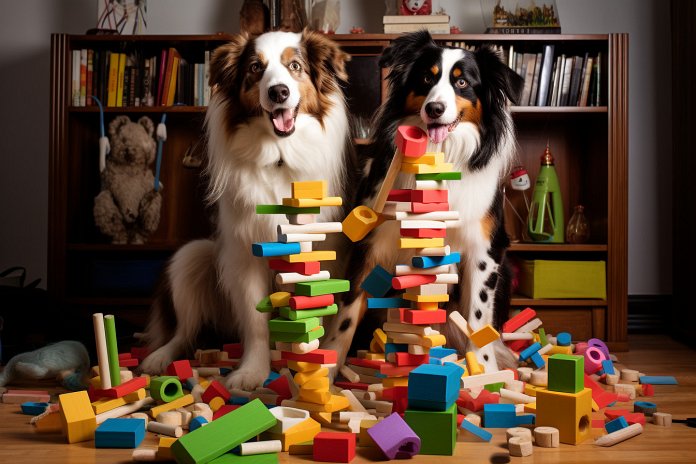
If your dog had to choose between a handful of treats or just one treat, which one do you think they would pick? Does that mean that your dog can count?
Dogs have many amazing abilities
Dogs have many amazing abilities. They can detect scents and hear things from far away. We rely on dogs for various tasks and they provide us with emotional companionship. We know that dogs are intelligent and loyal creatures, but do they understand quantity?
Signs Your Dog Understands Quantity
Your dog may show an understanding of quantity in different ways, depending on how you work with them. For example, if you work with your dog in the field, you may find that they can search for and retrieve the correct number of decoys. Or, you may notice that your dog is aware of the expected number of treats and pauses when they receive less than expected.
If you and your dog like to vocalize together, you may sing words to your dog and they may howl or bark back with sounds that match the number of syllables you just made. These behavior patterns suggest that dogs have an understanding of quantity.
Dogs communicate with their bodies. When engaged in a quantitative activity, your dog may show signs of alertness. They may bark or raise their ears in response to the activity. During fun activities, they may playfully bow as they engage with the quantitative play.
Dogs are smart and may demonstrate quantitative thinking by keeping their eyes focused, watching intently with raised ears. They may perform the quantitative task and then sit, attentively waiting for your next request. They may also demonstrate quantitative thinking by staring or showing search and selection behaviors.
Body Language
Some signs to watch for if your dog is gauging quantity include:
– Staring
– Being alert
– Barking
– Raising ears
– Raising paw
Other Signs
Other signs that your dog may show while figuring out quantity are:
– Recognizing familiar situations
– Searching behaviors
– Tapping of the paw or barking to the correct number
– Imitating the handler
History of Dogs Understanding Quantity
Quantity is a mathematical concept that helps humans and many species with survival. Studies have shown that various species, including dogs, have an understanding of quantity. However, domesticated dogs are not as dependent on quantity recognition for survival as their wolf ancestors. Wolves have better skills for discriminating quantity than domesticated dogs. It is believed that domestication has diminished the need for this skill.
Some dogs have demonstrated the ability to solve simple arithmetic problems. It is unknown if training or incidental learning experiences contributed to their ability.
The smartest dogs are those bred as working dogs, such as Border Collies, Poodles, German Shepherds, Golden Retrievers, Dobermans, Shetland Sheepdogs, and Labrador Retrievers.
Science Behind Dogs Understanding Quantity
Studies have been conducted to examine dogs’ ability to demonstrate quantitative reasoning. These studies are modeled after research on infants’ mathematical reasoning abilities. Dogs have shown an understanding of quantity in experiments where they spend more time looking at surprising numbers of treats.
Training Your Dog to Better Understand Quantity
To train your dog to play counting games, start by teaching them to touch a target on command. Then, assemble the necessary supplies for the training and math game. Begin with three items for the dog to count and three targets with numbers. Use treats and patience to train your dog.
Start by placing one item in front of the dog with the target for number 1. Say “One” and reward your dog when they press the target. Repeat and practice until your dog consistently points to the target for 1.
Move on to number 2, placing two items and the target with the number 2. Say “Two” and reward your dog when they choose the correct target. Practice with longer sequences and go back and forth between the numbers.
Once your dog is confident with numbers 1 and 2, you can proceed to number 3. You can make it more challenging by moving the target items around or placing them in different locations.
Safety Tips When Dealing with Dogs Understanding Quantity:
– Do not assume your dog will make decisions based on understandings of quantity.
– Use clear signals when working with your dog.
– Keep training intervals brief and positive.
“Unlocking the Mathematical Mind of Man’s Best Friend”

Tips & Things to Know
1️⃣ Dogs can demonstrate an understanding of quantity through various behaviors such as searching for the correct number of objects or pausing when expecting a certain number of treats. Pay attention to your dog’s body language, such as alertness, raised ears, or raised paw, as these may indicate their comprehension of quantity.
2️⃣ While dogs may not rely on quantity recognition for survival as much as their wolf ancestors, some dogs have shown the ability to solve simple arithmetic problems. Dogs bred as working dogs, like Border Collies and Poodles, have been identified as the most intelligent in terms of understanding quantity.
3️⃣ If you want to train your dog to better understand quantity, start by teaching them to touch on command. Then, gradually introduce counting games using targets with numbers and treats as rewards. Practice with longer sequences and consider adding challenges like moving the target items around or placing them in different locations. Remember to keep training sessions brief and positive, and use clear signals to communicate with your dog.
Frequently Asked Questions, Answered ✅
1. How can dogs demonstrate their understanding of quantity?
– Dogs can demonstrate understanding of quantity by searching for and retrieving the correct number of objects, pausing when less than expected treats are given, or howling/barking back with sounds that match the same number of syllables as vocalized words.
2. What are some body language signs that indicate a dog is thinking about math?
– Signs include staring, being alert, barking, raising ears, and raising a paw.
3. Do dogs have a natural ability to understand quantity?
– Dogs have some understanding of quantity, but it is believed that their domestication has diminished the need for this skill compared to their wolf ancestors.
4. Which dog breeds are considered the smartest?
– Border Collies, Poodles, German Shepherds, Golden Retrievers, Dobermans, Shetland Sheepdogs, and Labrador Retrievers are considered the most intelligent by experts.
5. How can you train your dog to better understand quantity?
– Train your dog to touch on command, provide targets with numbers, and reward your dog when they correctly touch the target for the corresponding number. Gradually increase the number of items and targets to train with longer sequences.